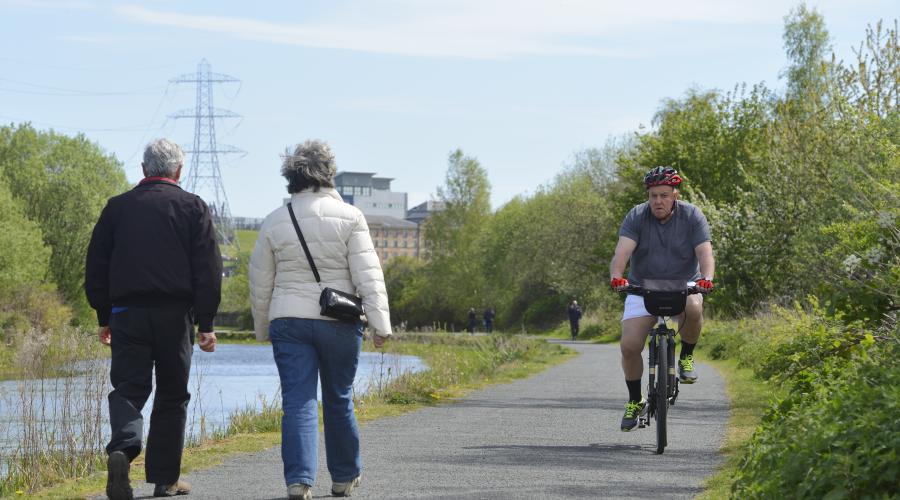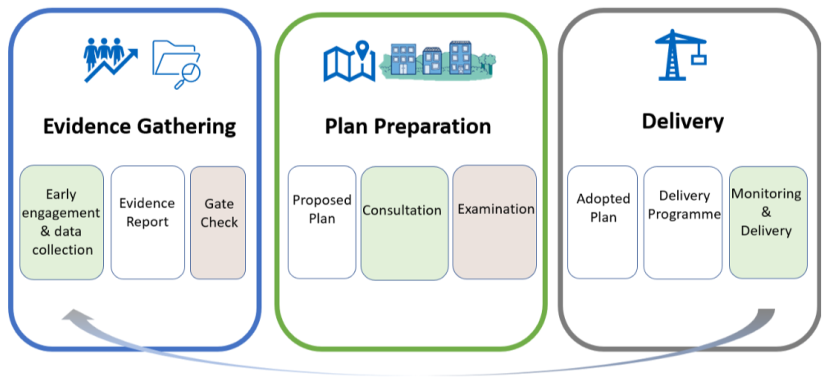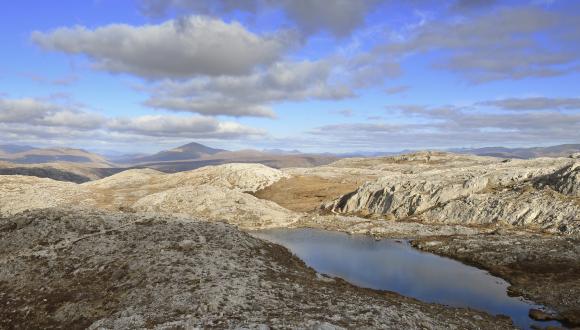
Planning authorities and Nature Networks
A simplifier outlining how planning authorities apply the requirements of NPF4 for Nature Networks into Local Development Plans.
A simplifier
To help tackle the nature emergency, the National Planning Framework 4 (NPF4), along with the Scottish Biodiversity Strategy to 2045, sets out an expectation that Nature Networks will be created in every council area in Scotland.
There are several policies within NPF4 referring to Nature Networks, and part of ‘Policy 3: Biodiversity’ for example, is to secure positive effects for biodiversity through ensuring development proposals are required to contribute to the enhancement of biodiversity by, among others, building and strengthening Nature Networks.
This guidance aims to help planning authorities apply the requirements of NPF4 for Nature Networks into Local Development Plans (LDPs).
What are Nature Networks?
The primary purpose of a Nature Network is ecological connectivity, working at the local, national and regional scale, to improve connectivity and contribute towards fully functioning and healthy ecosystems in the terrestrial and freshwater (including coastal) environment and increasing nature’s climate-resilience.
Nature Networks are primarily concerned with delivering strategic connections of ‘important areas for biodiversity’. This should include all 30x30 sites (apart from where there are sound reasons not to seek to connect a site e.g., an island) as well as those areas that are assessed as being locally important for biodiversity (e.g., Local Nature Conservation Sites/Local Nature Reserves or previous connectivity projects).
The connections between these areas should be delivered through ecological corridors (structural or functional – see Glossary), and where this is not possible, through ‘stepping stones’ of suitable habitat.
The spatially defined Nature Network is about identifying areas where the improvement or creation of habitats would contribute significantly to connectivity across the landscape for these important areas of biodiversity.
In addition to ecological connectivity, Nature Networks should seek to better connect local people to important sites for biodiversity. This can be achieved by delivering biodiverse active travel routes across towns/cities and out to important areas for biodiversity. Blue/green infrastructure with biodiversity at its core can help bring more species from important areas for biodiversity into built up areas.
What a Nature Network isn’t
The Nature Networks’ primary aim is for strategic regional connectivity between important sites for biodiversity at the national (30x30 sites) and local scale (Planning Authority defined). A Planning Authority spatially defined Nature Network is not expected to increase connectivity across every part of the Planning Authority’s area.
Nature Networks are not the sole means by which connectivity, and ecosystem health, can be improved. There are a number of streams of work that are ongoing that are concerned with improving the health of ecosystems, many of which will in turn lead to an increase in connectivity (i.e., the developing Agriculture and Rural Communities Bill, or individual actions within the draft SBS Delivery Plan such as those on Ecosystem Restoration or on Deer and Grazing).
Some projects may not directly contribute to Nature Networks in themselves, for example because they do not contribute towards a coherent network. As these projects may still improve connectivity for biodiversity or between people and biodiversity, they will nevertheless count towards broader aims of enhancing biodiversity.
Key Roles of Planning Authorities
Planning Authorities are not expected to have a major role in driving action on the ground across the entirety of a Nature Network, the vast majority of land under a spatially defined Nature Network being under private ownership. Direct roles of PAs include:
- Spatially defining Nature Networks in Local Development Plans (LDPs), connecting together 30x30 sites and locally important for biodiversity sites (LBAP) – ideally in partnership with relevant stakeholders (SBS Delivery Plan).
- The safeguarding and enhancement of Nature Networks through the planning system/planning decisions, use of ‘positive effects for biodiversity’ in particular (NPF4)
- The undertaking of projects on publicly owned land to enhance connection, particularly that the increased the connection between people and nature.
- Communication of Nature Networks, their purpose and benefit to local population
- Take advantage of overlaps with climate policies under Policy 1 and 2 of NPF4 with healthy ecosystems being critical to mitigating climate change.
Wider Roles
- Where a planning authority is developing policies, land use/other strategies (e.g., Tree/Woodland Strategies) that have the ability to promote, enhance or provide security to Nature Networks opportunities should be taken to mainstream this area of work.
- Influencing wider local/regional planning policy statements e.g., via community planning, social care partnerships, growth deals.
Nature Networks Implementation and Management
Nature Networks are similar to other spatially defined policies such as Local Nature Conservation Sites and Green Networks in that the Planning Authority does not necessarily have control over how an area is managed or, whether or not desired action is carried out.
As Nature Networks seek to better connect isolated areas of importance for biodiversity it is a given that the vast majority of land under any connection will be private land in rural locations. For the majority of urban PAs, where there may be few if any 30x30 sites, it is instead locally important sites being connected. For such urban authorities it may be the case that the LA, or other public bodies, may be the main owner of land providing possibilities for biodiversity enhancement and connections and so there will be a more significant role for them in delivering Nature Networks.
Identifying a spatially defined Nature Network does not force land owners/managers to make changes. Instead, it is for government and fund giving public bodies to encourage positive action through opportunities for funding or investment in these areas.
Whilst the Nature Restoration Fund (NRF) or similar may contribute to work in these areas, other funding measures/policies such as rural payments (e.g., AECS and its successor), Scottish Forestry forest grant schemes (FGS), NatureScot administered Peatland Action funding or private peatland funded restoration/wider private finance (biodiversity credits/natural capital) are likely to be more important given the underlying land use, the scale of funds available and their existing applicability to land use management or change.
Through Planning Authorities ensuring Nature Networks are clearly spatially defined, they are playing their part in allowing the direction of support for implementation to these areas.
The future of Nature Networks
Given the complexity of the natural world, land use, land use change and climate change it is highly likely that spatially defined Nature Networks will need to be altered over time. This may be to improve their role in providing connectivity following local input/an increase in understanding or, to accommodate a development for which it was not possible to mitigate against. Monitoring requirements and managing the LDP through the Delivery Plan should be useful in making required changes in future LDPs.
What’s important is that the coherence of the overall network, and its aims, are maintained.
Finally, it is hoped that whilst Planning Authorities identify the ‘core’ Nature Network, locally led initiatives will help it to grow over time, adding further branches to the network so benefitting local communities and biodiversity further still.
Nature Networks and Local Development Plans
This note sets out the context for Nature Networks in Local Development Plans (LDPs), including what is relevant at different stages.
Nature Networks in NPF4 Policy
Policy 3 - Biodiversity
- Relevant Policy Outcomes: Biodiversity is enhanced and better connected including through strengthened nature networks and nature-based solutions.
- Role of LDPs: Facilitating the creation of nature networks and strengthening connections between them to support improved ecological connectivity.
Policy 4 – Natural places
- Relevant Policy Outcomes: Natural places are protected and restored. Natural assets are managed in a sustainable way that maintains and grows their essential benefits and services.
- Role of LDPs: Spatial strategies [should also] better connect nature rich areas by establishing and growing nature networks to help protect and restore the biodiversity, ecosystems and natural processes in their area.
Policy 6 – Forestry, woodland and trees
- Relevant Policy Outcomes: Existing woodlands and trees are protected, and cover is expanded. Woodland and trees on development sites are sustainably managed.
- Role of LDPs: Identify and protect existing woodland and the potential for its enhancement or expansion to avoid habitat fragmentation and improve ecological connectivity, helping to support and expand nature networks.
Policy 8 – Green belts
- Relevant Policy Outcomes: The character, landscape, natural setting and identity of settlements is protected and enhanced. Nature networks are supported and land is managed to help tackle climate change.
- Role of LDPs: No specific nature network role identified for LDPs.
LDPs are not expected to duplicate NPF4 policy but may add detail or place-based specific policies.
The LDP process and touch points for work on nature networks
The new approach to preparing LDPs is broken down into three main stages, with 3 steps in each.

Diagram showing the steps when developing a local development plan:
1. Evidence gathering: Early engagement and data collection, Evidence Report and Gate Check.
2. Plan preparation: Proposed Plan, Consultation, Examination.
3. Delivery: Adopted Plan, Delivery Programme and Monitoring and Delivery.
In broad terms, the evidence gathering stage is what the plan needs to take account of, while the plan preparation stage is where things should happen. For nature networks, this means we should focus on the following:
Stage - Early engagement & data collection
Planning Authorities should gather information on existing nature networks – this should not focus on site specifics at this stage. Outputs should be presented spatially.
NatureScot will work with planning authorities to identify relevant data and discuss their priorities for nature networks in their area.
Stage - Evidence Report / Gate Check
NatureScot should confirm that we agree with the evidence presented in the Evidence Report.
However, Planning Authorities may consider that they do not have sufficient evidence on nature networks at this point. Provided it is possible to confirm that evidence will be available in time for the Proposed Plan, NatureScot will provide assurance to the Reporter on the appropriateness of this approach.
Discussions on how we could work together at the next stage of preparing the Proposed Plan would be useful at this point.
Stage - Proposed Plan
Proposals will cover the 10 years of the plan’s life, but the plan may identify broad areas with potential for development beyond ten years. This longer-term view will be important for nature networks.
This stage is to be collaborative, and NatureScot will work with Planning Authorities and other relevant stakeholders to develop the nature network in their LDP.
Due to the lifespan of the LDP and the potential for change in nature networks during this period, opportunities for preparing a Nature Networks Plan alongside the LDP could be explored.
Stage - Consultation
Formal process that has a statutory minimum period of 12 weeks.
NatureScot will provide representations on the Proposed Plan that are concise and clearly explain the issues we wish to be considered. If we agree with and support what the Planning Authority has planned for nature networks, we will say this.
Stage - Delivery Programme
NatureScot has a duty to cooperate in the preparation of the Delivery Programme.
The aim is to prioritise deliverability of the LDP and we recommend early consideration of how nature networks sit within this, particularly as part of an infrastructure first approach to planning. The potential to develop a separate Nature Networks Plan that is clearly identified in the Delivery Programme should be explored.
Stage - Monitoring & Delivery
This stage will provide important information for beginning the next round of evidence gathering.
We recommend a review of success, potential for improvement in approach and identification of changes to the nature network that should be reflected in the next LDP at this stage.




